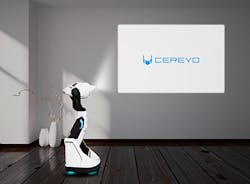There are few things tech geeks like more than talking about the future and how it is unfolding right before our eyes, which is why the Consumer Electronics Show in Las Vegas is such a big deal.
We all get to see the future right now, if not on the trade show floor, on our smartphones, tablets, and laptops. Then of course we complain about how it’s not as good as we imagined.
Next year, that list will be amended to include virtual and augmented reality ingénues, Oculus Rift and Microsoft HoloLens, respectively.
The 2016 event, running now until Jan. 9, has added at least one more option: the Cerevo Tipron, a “transforming, Internet-connected projection robot.”
Along with appearing to be the love child of the Pixar lamp and HAL 9000, Tipron seems at first glance to be another novel Japanese robot, a giant Tamagotchi compared to the 100% sexy, 0% polluting Faraday Future which has owned CES 2016 so far.
According to the company, this mobile entertainment system is capable of projecting an 80-inch HD (1280 x 720) display from about 10 feet away. The camera range of motion reaches 90-degrees along the pitch, yaw, and roll axes, and the 31-inch body can collapse to 15 inches while charging or transiting.
Functionally, it can do a lot more than post PowerPoint presentations. It has a speaker and HDMI input, so you can watch movies, play a game console or stream live video. An Android-based app controls the movement and receives live video from Tipron’s five-megapixel camera. An IR distance camera and ultrasonic obstacle sensor, give it the ability to steer around obstacles autonomously.
You can also preset Tipron to appear in locations at certain times. For example, you can send it to your child’s rooms to treat him or her to an impromptu midnight screening of “The Shining.”
One other upside: it will keep you from getting "text neck," which is the constant ache you feel in your upper vertebrae from staring down at your phone all day. if you're feeling pain just reading this, the Cleveland Clinic has a few exercises to try out.
Cerevo markets Tipron as a “home robot,” though this design may lend itself a bit better for the factory floor than your living room.
For the estimated $1,000 to 2,000 price tag, you could just buy a few smart TVs to mount on your walls. In an industrial environment, having an automated, battery-powered projector on call to flash schematics on a wall, or to project videos in the training room makes more sense.
Battery life is by far the biggest downside. The 3,000-mAh battery powers Tipron for two hours, and takes that same amount to charge. Another feature that probably needs to be improved is the Internet connectivity, as the company press release says certain functions “will be improved and added so various video streaming services can be used with Tipron.”
The projector will be available this spring, so by then, it may be able to stream Hulu or Netflix like a smart TV. And hopefully, the battery will soon be improved, as you won’t even be able to make it through two episodes of “Making a Murderer” on one charge.
And what about making the projections actual holograms, as R2D2 could. At the very least, combine the laser technology employed by this super cool R2D2 keyboard to create a giant interactive display that can be projected on the side of a giant piece of machinery or brick wall, so workers wearing thick gloves could enter data by simply breaking the light plane.
Now that would be something to see.
Oh, well. I guess we'll just have to settle for being kind of amazed with stuff that actually exists this year.













